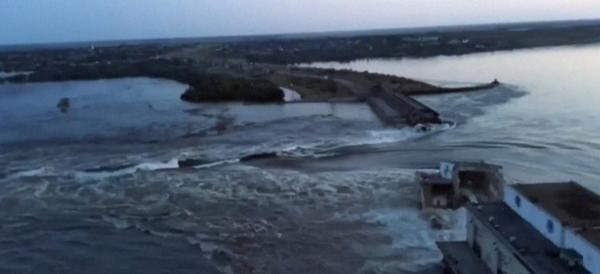The Destruction of Nova Kakhovka Dam: a review
22 Jun 2023 by The Water Diplomat

The Nova Kakhovka Dam, Ukraine’s largest dam by volume with a reservoir containing approximately 18 km³ of water, was destroyed on the 6th of June, releasing a high energy wave down the Dnieper River that caused catastrophic flooding. The floods have so far caused 45 confirmed fatalities, destroyed villages, inundated farmland and cut off clean water supplies in the lower section of the Dnieper River for more than 1 million people. According to a telegram message posted by President Zelensky, about 80 settlements with a potentially impacted population of 100,000 are located downstream of the dam. Amongst these are Kherson, a city with a population of 300,000, of which, according to sattelite observations, some 19% was flooded as a result of the collapse of the dam. By the 7th of June the water reached its highest point at 5,6 metres on the right bank of the river. The humanitarian research organisation REACH provided a Situation Overview on the 16th of June which indicated that evacuees had in general left their homes rapidly with very few items and remained in dormitories and other shelters close to their places of residence in order to be able to return quickly after the waters subside. Denise Brown, UN humanitarian coordinator for Ukraine, released a statement on the 18th of June, indicating that it had been engaging with the Governments of Ukraine and the Russian Federation regarding effective delivery of humanitarian aid to all people affected by the destruction of the Kakhovka Dam. However, the government of the Russian Federation has reportedly declined requests to access the areas under its military control.
Local leadership is also reported to have expressed concern about the health impacts of the release of 465,000 tons of transformer oil from the Kakhovka Hydroelectric Power Plant. Similarly, REACH’s analysis identified 134 potentially hazardous structures potentially affected by flooding, including 24 hazardous industrial facilities. The oil and industrial pollutants pose a threat for downstream soil as well as wildlife and vegetation. The floods have also transported large amounts of debris to the coast, including animal carcasses, tress and even landmines, leading to the prohibition of recreation activities along the coastline in areas such as Odesa.
Ukrainian Deputy Foreign Minister Andriy Melnyk described the environmental impact of the dam as "the worst environmental disaster in Europe since Chernobyl," with more than 48 protected areas at risk from the pollution. Ukraine’s prosecutor general has launched and investigation into the event as a possible instance of ecocide.
As of the 20th of June, Ukrainian Environment Minister Ruslan Strilets reported to European counterparts that although assessments were still ongoing, an estimated U.S. $ 1.2 billion in damage had been inflicted by the floods. He further noted that the collapse of the dam was the largest environmental disaster since the February 2022 invasion of Ukraine.
As predicted in early June, the drop in the water levels in the dam reservoir effectively cut the water supplies to the North Crimea Canal. The canal transfers water to northern Crimea, feeding water to an extensive network of irrigation canals across 31 irrigation systems which serviced some 584,000 hectares of cropland. This development can be expected to further undermine agricultural production in Ukraine. The Ukrainian Ministry of Agriculture has warned of the rapid desertification of large areas of cropland as early as next year. Martin Griffiths, the UN Undersecretary-General for Humanitarian Affairs and Emergency Relief Coordinator, warned of the secondary consequences of the destruction of the dam, which would have an impact on both global food prices and food availability. Speaking to the BBC, Mr Griffiths stated: "This is a breadbasket - that whole area going down towards the Black Sea and Crimea is a breadbasket not only for Ukraine but also for the world, .. […] … we're in difficulties already on food security but food prices, I'm sure, are bound to increase."
